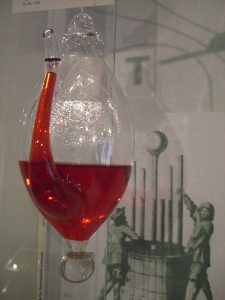Goethebarometer – Deutsch/German

Ein für Bauern äußerst wichtiges Messinstrument war lange Zeit ein mit Wasser gefülltes halbkugelförmiges Glasgefäß mit langer Tülle. Dieses Wetterglas zeigte den Bauern an, ob es Regen geben oder die Sonne scheinen würde. War Sonne angesagt, konnte mit der Ernte begonnen werden.
Da das Wetterglas so wichtig für die Bauern war, gab man dem Instrument den Namen Bauernbarometer. Und weil der Luftdruck durch den Wasserstand angezeigt wird, nennt man es auch Wasserbarometer. Am bekanntesten ist das Barometer jedoch unter dem Namen „Goethebarometer“ – eine Bezeichnung, die auf einem Irrtum beruht.
Als nämlich der Dichter Johann Wolfgang von Goethe 1832 in Weimar verstarb, entdeckte man in seinem Schlafzimmer an der Wand ein mit Wasser gefülltes Glasgefäß. Zunächst wusste niemand so recht, was es mit diesem Glasgefäß auf sich hatte. Da jedoch Goethes naturwissenschaftliches Interesse allseits bekannt war, wurde bald klar, dass es sich um ein Wetterglas handeln musste. Barometer waren zu dieser Zeit zwar schon in Gebrauch, trotzdem scheinen sie in Deutschland wenig bekannt gewesen zu sein. Daher glaubte man lange Zeit, dass Goethe der Erfinder des Wetterglases sei.
Scheint die Sonne, sinkt das Wasser in der Tülle. Denn der höhere Druck der umgebenden Luft drückt das Wasser in den Glaskolben. Es herrscht Hochdruck! Regnet es, steigt das Wasser in der Tülle, da der äußere Druck nachlässt. Es herrscht Tiefdruck. Wenn das Wasser aus der Tülle tropft, ist Sturm angesagt.
Goethe Barometer – English

The teardrop-shaped measuring instrument with long spout that was filled with water was once a farmer’s best, if not indispensable, friend. The weatherglass showed the farmer whether it was going to be wet or sunny and if the sun was going to shine, the harvest could begin.
Not surprisingly then, the instrument was called a farmer’s barometer, or a water barometer because the water level inside recorded the air pressure. But it’s more widely known as a „Goethe Barometer“ – a label that’s based on a mistake.
When the poet, Johann Wolfgang von Goethe died in Weimar in 1832 a water-filled receptacle was discovered on his bedroom wall and nobody really knew what it was for. As Goethe’s interest in the natural sciences was well known it soon became clear that it was in fact some sort of weatherglass. Barometers were in use at the time, but appear to have been less widespread in Germany. Thus, for a long time, Goethe was thought to have invented the weatherglass.
When the sun shines the water level in the spout sinks because the higher pressure of the surrounding air pushes the water into the glass flask. If it rains, the external air pressure reduces and the water rises in the spout, but should the water drip out of the spout – a storm is approaching!